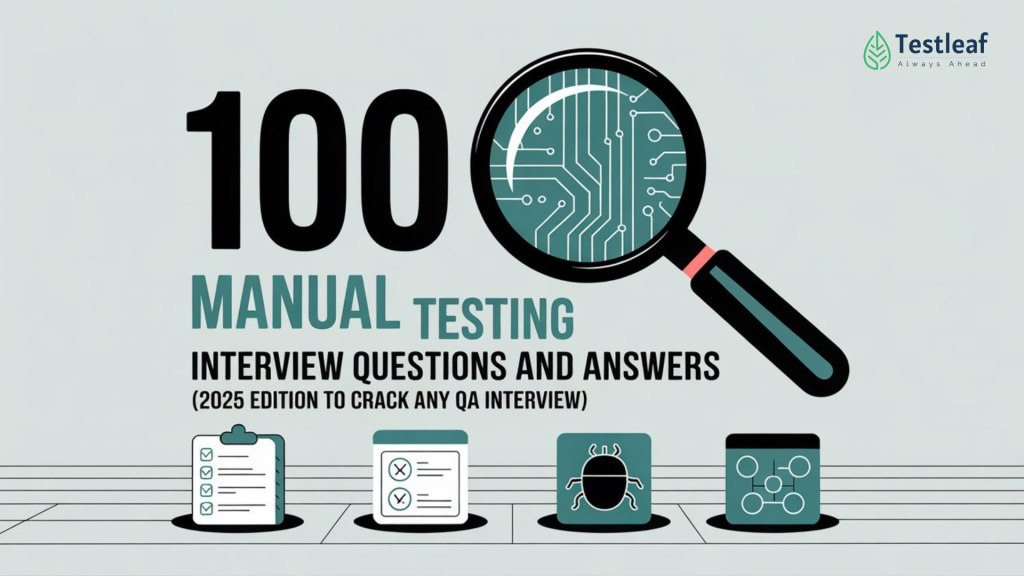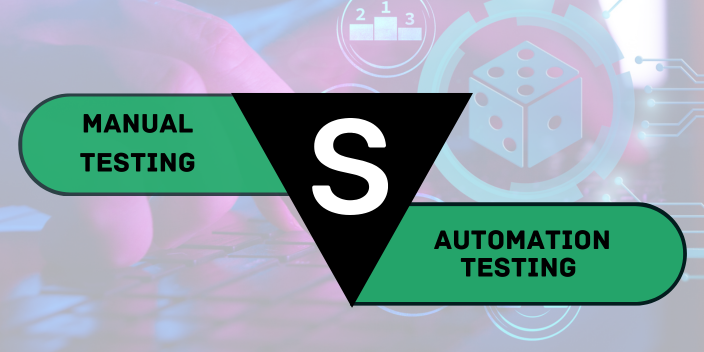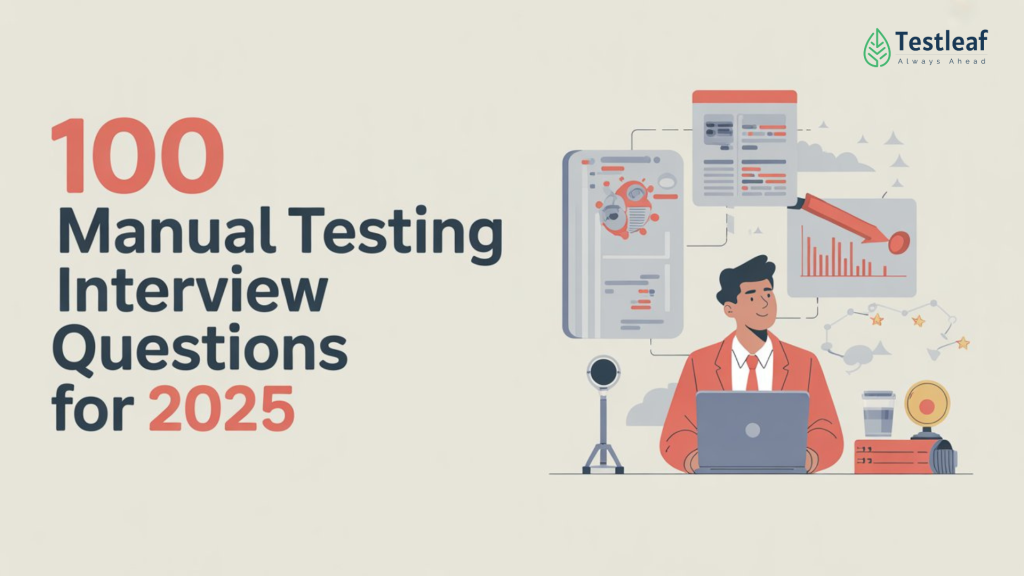In the fast-paced world of software testing, manual testing remains an integral part of ensuring the functionality and reliability of applications. Whether you’re preparing for an interview or looking to enhance your manual testing skills, understanding the essential concepts of manual testing is key. This blog serves as the follow-up to our previous article, where we discussed 100 manual software testing interview questions. In this post, we dive into the answers to those questions, giving you the insights and knowledge necessary to master manual testing in 2025.
100 Manual Testing Interview Questions and Answers for 2025
Basics of Software Testing
1. How do you define software testing and its purpose in software development?
Software testing is a structured activity of examining a software system to validate its behavior against requirements and uncover hidden defects. Its purpose is to ensure correctness, completeness, and reliability, increase user confidence, and prevent costly production issues by detecting defects early.
2. Can you explain the difference between verification and validation with examples?
Verification ensures the product is built as per specifications (“Are we building it right?”), for example by reviewing requirement documents, while validation ensures the product meets user needs (“Are we building the right thing?”), for example through User Acceptance Testing.
3. How does Quality Assurance (QA) differ from Quality Control (QC)?
Quality Assurance (QA) is process-oriented and preventive, such as defining coding standards, while Quality Control (QC) is product-oriented and detective, such as executing functional testing.
4. What are the phases of the Software Development Life Cycle (SDLC)?
The Software Development Life Cycle (SDLC) is composed of requirement gathering, system and design planning, coding and implementation, quality validation through testing, deployment to production, and ongoing maintenance for improvements.
5. Walk me through the Software Testing Life Cycle (STLC).
The Software Testing Life Cycle (STLC) involves requirement analysis, test planning, test case design, test environment setup, test execution, and test closure with reporting.
6. What is meant by dynamic testing, and when is it applied?
Dynamic testing involves executing code at runtime and is applied after build deployment, such as in functional or system testing.
7. How does static testing work, and what is its purpose?
Static testing checks requirements, design, or code without execution, using reviews, walkthroughs, or inspections, with the purpose of finding defects early.
8. Can you describe white-box testing and its applications?
White-box testing is based on code and logic, applied in unit testing or to achieve path and condition coverage.
9. What is black-box testing, and where is it most useful?
Black-box testing is focused on inputs and outputs without knowledge of code and is most useful in functional, system, or acceptance testing.
10. How would you differentiate between positive testing and negative testing with examples?
Positive testing checks valid input, such as logging in with correct credentials, while negative testing checks invalid input, such as entering the wrong password.
Test Planning and Strategy
11. What is gray-box testing, and how does it differ from black-box and white-box?
Gray-box testing combines both white-box and black-box approaches; for example, testing a UI with partial knowledge of the database schema.
12. How would you describe a test strategy and its role in QA?
A test strategy is a comprehensive guideline that outlines the overall testing philosophy, goals, scope, resource allocation, and risk considerations, serving as a roadmap for all QA activities.
13. How would you define a test plan, and what process would you follow to build it effectively?
A test plan is a detailed document describing testing objectives, schedules, resources, and deliverables, created through requirement analysis, scope definition, estimating effort, identifying risks, and finalizing approvals.
14. What is a test scenario, and how do you design one?
A test scenario is a high-level description of what to test, such as verifying that a user can transfer funds between accounts.
15. How would you explain a test case with an example?
A test case is a step-by-step instruction with inputs and expected outputs, such as entering valid credentials and expecting the dashboard to load.
16. What is meant by a test bed in manual testing?
A test bed is the complete setup of infrastructure—hardware devices, operating system, test data, configurations, and supporting tools—designed to facilitate effective testing activities.
17. Can you describe what a test suite is and in which stage of testing it is usually prepared?
A test suite is a logical collection of test cases, usually prepared before execution.
18. How do you define test data, and why is it important?
Test data consists of input values used during testing and is important to ensure realistic and accurate results.
19. Explain the defect life cycle with stages.
The defect life cycle has stages: new, assigned, open, fixed, retested, verified, and then either closed or reopened.
20. How do smoke tests and sanity tests differ in purpose and execution?
Smoke testing is a broad, shallow check of major functionality after a build, while sanity testing is a narrow, deep check of a module after changes.
Defect Management and Reporting
21. Can you explain entry and exit criteria in the context of software testing with real-world examples?
Entry criteria are conditions required before testing begins, such as build deployment and test data readiness, while exit criteria are conditions for closing testing, such as meeting a pass percentage and fixing critical defects.
22. In defect management, what does a “blocker” mean?
A blocker is a defect that halts further testing or development, such as a login page failure that prevents all other test cases.
23. How do you explain regression testing with an example?
Regression testing ensures recent changes haven’t broken existing functionality, for example retesting checkout after a cart bug fix.
24. What is retesting, and how does it differ from regression?
Retesting is re-executing failed test cases after a fix, while regression checks that other areas remain unaffected.
25. What is monkey testing, and how is it performed?
Monkey testing is a randomized approach where testers or tools input unpredictable data or actions without predefined test cases, mainly to check the resilience and robustness of the system under unexpected conditions.
26. How would you differentiate between severity and priority of a defect?
Severity indicates the degree of technical damage a defect causes to the application, whereas priority reflects the business urgency with which the defect must be addressed and resolved.
27. What is meant by defect priority?
Defect priority defines the order in which defects must be fixed, with high priority assigned to issues like a checkout failure.
28. What is meant by defect severity?
Defect severity reflects the technical impact, such as a crash being high severity and a typo being low severity.
29. Provide real-world examples of software defects that fall into each category.
Examples include: a typo (low severity, low priority), a crash in a rarely used feature (high severity, low priority), a misaligned logo (low severity, high priority), and payment gateway failure (high severity, high priority).
30. What is unit testing, and who performs it?
Unit testing validates individual components and is usually performed by developers.
Levels and Types of Testing
31. How does integration testing work, and why is it important?
Integration testing verifies interactions between modules, such as a login module and its user database, to ensure correct data flow.
32. What is system testing, and what does it validate?
System testing validates the entire system end-to-end against both functional and non-functional requirements.
33. What is user-acceptance testing, and who conducts it?
User Acceptance Testing (UAT) validates that the system meets business needs and is performed by end-users or client representatives.
34. What are alpha and beta testing, and how are they different?
Alpha testing is performed internally before release, while beta testing is done by external users in real scenarios.
35. How is monkey testing different from ad-hoc testing?
Monkey testing is purely random, while ad-hoc testing is informal but guided by tester knowledge.
36. Could you walk me through Test Driven Development (TDD) and explain how it fits into the development cycle?
Test-Driven Development (TDD) writes tests before writing code, ensuring code meets defined expectations through a cycle of write test, fail, code, pass, refactor.
37. Can you explain Equivalence Class Partitioning with an example?
Equivalence Partitioning divides input into valid and invalid classes; for an age field 1–100, 25 is valid while −5 and 150 are invalid.
38. How does boundary value analysis work in test design?
Boundary Value Analysis tests values at the edges, such as 0, 1, 100, and 101 for an input range of 1–100.
39. What attributes are generally included in a defect report?
A defect report usually contains an ID, description, severity, priority, steps to reproduce, expected vs actual result, environment, status, and assignee.
40. What is a stub in testing?
A stub is a dummy lower-level module, such as simulating a payment service that always returns success.
Test Design Techniques
41. What is a driver in testing?
A driver is a temporary higher-level program to test lower modules, such as a driver calling a login function before the UI is ready.
42. What are the key benefits of automation testing?
Automation testing offers benefits like faster execution, reusability, fewer errors, CI/CD support, and long-term cost savings.
43. What are the drawbacks or risks of automation testing?
Risks of automation include high initial costs, maintenance overhead, unsuitability for exploratory testing, and the need for skilled testers.
44. Compare the Waterfall Model with Agile methodology.
Waterfall is sequential and rigid with late testing, while Agile is iterative, flexible, and emphasizes continuous feedback.
45. How would you define a test plan, and what process would you follow to build it effectively?
A test plan details the testing scope, schedule, approach, and deliverables, created through requirement analysis, scope definition, test design, resource planning, risk analysis, and approvals.
46. Can you explain how system testing differs from integration testing in terms of scope and objectives?
Integration testing focuses on module interactions, while system testing validates the complete application end-to-end.
47. What does verification mean in the context of testing?
Verification checks whether software is built correctly against specifications without executing code, using reviews and static analysis.
48. What are the main differences between boundary value analysis and equivalence partitioning in test design techniques?
Equivalence Partitioning reduces test cases by dividing inputs into classes, while Boundary Value Analysis tests edges of ranges.
49. What is the difference between authentication and authorization?
Authentication verifies identity, such as logging in with credentials, while authorization checks permissions, such as admin rights.
50. Explain the steps involved in reviewing a test case.
Reviewing a test case involves stakeholder walkthroughs, validation of coverage, logging comments, and final updates.
51. Differentiate between regression testing and retesting.
Regression testing ensures new changes don’t affect existing functionality, while retesting checks previously failed test cases after a defect fix.
52. What is the purpose of using Equivalence Class Partitioning (ECP)?
Equivalence Class Partitioning reduces the number of test cases while maintaining effective coverage by testing representative values.
53. Which Black Box Test Design techniques are most commonly applied, and why?
Equivalence Partitioning, Boundary Value Analysis, Decision Table Testing, and State Transition Testing are commonly applied because they provide high coverage with fewer test cases and align with business scenarios.
54. Can you explain random testing and describe scenarios where it is most effective?
Random testing selects inputs without design and is effective for stress testing, performance testing, or robustness checks.
55. Why do we use test design techniques in software testing?
Test design techniques ensure systematic coverage, reduce redundancy, detect defects early, and improve test quality.
56. What is use case testing, and what are its benefits?
Use case testing designs test cases from system use cases, aligning tests with user behavior and ensuring end-to-end validation.
57. What is equivalence testing in design techniques?
Equivalence testing is another name for Equivalence Partitioning, where inputs are divided into valid and invalid classes to minimize redundant test cases.
58. How does State Transition Testing work?
State Transition Testing validates system behavior during state changes, such as an ATM card moving from insert → PIN entry → transaction → eject.
59. How would you categorize and explain the different types of test design techniques used in QA?
Test design techniques are categorized into specification-based (black-box), structure-based (white-box), and experience-based (exploratory/error guessing).
60. What is a walkthrough in static testing techniques?
A walkthrough is an informal review where the author explains a document to peers to identify defects.
Static Testing Techniques
61. What is a technical review in static testing?
A technical review is a structured peer review of technical documents, such as design or code, performed with subject matter experts.
62. What are static testing techniques, and how are they applied?
Static testing techniques include reviews, walkthroughs, inspections, and static analysis, applied early in the SDLC to detect defects without execution.
63. What are the main uses of static testing?
Static testing identifies defects early, improves design and code quality, and reduces rework and costs.
64. What happens during the kick-off stage of a formal review process?
During kick-off, objectives, roles, scope, procedures, and documents are defined, and the review team is introduced.
65. What is a formal review in testing?
A formal review is a structured process, such as inspections, that uses defined roles, checklists, and metrics.
66. What is informal review in static testing?
An informal review is a casual review, such as desk checks or pair programming, without a defined process.
67. What does specification-based testing mean?
Specification-based testing follows a black-box approach, where test scenarios are designed straight from documented requirements and functional specifications without considering internal code.
68. Can you explain decision table testing?
Decision table testing is a black-box technique that models conditions and actions in tabular form, useful when input combinations yield different outcomes.
69. What are the key benefits of decision table testing?
Decision table testing ensures full coverage of input combinations, identifies missing requirements, and reduces redundant test cases.
70. What is an experience-based testing technique?
Experience-based testing leverages the tester’s past knowledge, domain expertise, and gut instinct to create effective test conditions.
Advanced & Non-Functional Testing
71. What are the different types of experience-based test design techniques?
The types are exploratory testing, error guessing, and checklist-based testing.
72. Could you describe the Boundary Value Analysis technique and explain its importance in testing?
Boundary Value Analysis tests inputs at minimum, maximum, and just-inside/outside boundaries, which is important because many defects occur at edges.
73. What is exploratory testing, and when is it useful?
Exploratory testing combines learning, test design, and execution without predefined cases, and is useful in early-stage or time-constrained projects.
74. What is equivalence partitioning, and how is it used in testing?
Equivalence Partitioning groups input data into classes of expected valid and invalid ranges, where testing a single sample from each class is sufficient to represent the whole group.
75. How would you categorize and explain the different levels of testing within the software development process?
Levels of testing include unit testing for components, integration testing for module interaction, system testing for end-to-end validation, and acceptance testing for business approval.
76. How would you classify different categories of defects?
Defects may appear in different forms, such as functional logic failures, performance bottlenecks, user interface glitches, or security vulnerabilities.
77. On what basis is an acceptance plan prepared?
An acceptance plan is prepared based on business requirements, user needs, and critical success factors.
78. What is the cost impact of detecting and fixing a defect late in the development lifecycle instead of early?
The cost of fixing defects increases exponentially at later stages, with post-deployment fixes costing 10–30 times more than early-stage fixes.
79. What factors or metrics would you consider when estimating effort and timelines for a testing project?
Factors include requirement complexity, number of test cases, test environment readiness, resource availability, risks, and defect density from past projects.
80. Can you describe performance testing and explain why it is essential before deployment?
Performance testing evaluates speed, scalability, and stability under load, ensuring the system meets SLAs, prevents crashes, and handles production traffic.
81. How do load testing and stress testing differ?
Load testing measures system behavior under typical or anticipated user loads, whereas stress testing deliberately overloads the system to find its breaking threshold.
82. What does concurrent user load mean in performance testing?
Concurrent user load refers to the number of users performing transactions simultaneously.
83. How do you determine if performance testing is necessary before deploying an application to production?
Performance testing is necessary if the application has a large user base, strict SLAs, or business-critical transactions.
84. What is the purpose of security testing?
Security testing identifies vulnerabilities, prevents attacks, and ensures data confidentiality and integrity.
85. What is endurance (soak) testing?
Endurance or soak testing runs the system under normal load for extended periods to check stability and memory leaks.
Agile and Scrum Interview Questions
86. Could you explain spike testing and describe scenarios where it becomes essential?
Spike testing focuses on assessing system behavior when workload suddenly rises or drops within a short period, ensuring the application can withstand abrupt fluctuations without crashing.
87. How does functional testing differ from non-functional testing?
Functional testing ensures that application features work as intended per requirements, while non-functional testing checks overall system qualities such as speed, reliability, scalability, and user-friendliness.
88. In what way does the Software Testing Life Cycle align with the Software Development Life Cycle, and which testing tasks are performed in each stage?
In SDLC, requirement analysis maps to test requirement analysis, design maps to test planning, development maps to test case design, testing maps to execution and defect reporting, and deployment maps to UAT and regression.
89. Who is responsible for preparing test cases?
Test case design is typically handled by QA professionals, often refined with insights from developers or business analysts for completeness.
90. How are test cases connected to test data, and why is this relationship important?
Test cases specify what to test, while test data provides the values to test, ensuring realistic and accurate execution.
91. What are some methods to collect test data?
Test data can be collected from masked production data, manually created values, generated tools or scripts, or inputs from business analysts.
92. Is test data mandatory for every test case?
Test data is not mandatory for all cases, such as UI layout checks, but is critical for functional validations.
93. How do testers derive test cases from requirements?
Testers derive test cases by reviewing requirement documents, creating scenarios for positive and negative flows, and applying design techniques such as BVA and ECP.
94. In your view, what makes a test case clear, effective, and reusable?
A good test case is simple, unambiguous, covers both positive and negative scenarios, is linked to requirements, and uses reusable modular steps.
95. Can you differentiate between a test scenario and a test case with suitable examples?
A test scenario is high-level, such as testing login functionality, while a test case is detailed, such as entering credentials and checking the dashboard.
Practical Test Case Questions
96. How do positive test cases differ from negative ones, and why are both important in testing?
Positive test cases validate expected behavior with valid input, while negative test cases validate error handling with invalid input, ensuring system robustness.
97. How would you explain Agile Methodology?
Agile is an iterative approach that delivers software in short sprints with continuous feedback and adaptability to changing requirements.
98. What is Scrum, and how does it work?
Scrum is an Agile framework with 2–4 week sprints that use ceremonies like planning, daily standups, sprint reviews, and retrospectives to ensure progress.
99. Can you outline the primary roles in a Scrum team and explain their responsibilities?
Within Scrum, the Product Owner defines and prioritizes business needs, the Scrum Master ensures the framework runs smoothly and resolves obstacles, while the Development Team focuses on delivering and validating working increments.
100. What is the purpose of a Scrum meeting?
A Scrum meeting is a daily stand-up where team members share what they did yesterday, what they plan today, and any blockers.
Conclusion
We’ve covered 100 critical manual testing interview questions and answers that are essential for anyone preparing for a software testing role in 2025. These questions touch on various aspects of manual testing, from fundamental concepts to more advanced testing techniques.
By familiarizing yourself with these questions and their answers, you can significantly boost your chances of success in interviews. Continuously learning new tools, methods, and industry best practices in manual testing is essential to remain relevant and excel in today’s competitive software landscape.
For a deeper understanding of how to approach these questions, make sure to revisit our first blog on 100 Manual Testing Interview Questions where we discuss how to effectively handle each question.
Get ready to master manual testing in 2025! By understanding both the questions and answers, you’re one step closer to becoming a proficient software tester.
FAQs
Are manual testing interview questions still important in 2025?
Yes. Manual testing remains critical for exploratory, usability, and ad-hoc testing where automation alone is insufficient.
What are the most common manual testing interview questions?
Questions about SDLC, STLC, test cases, defect lifecycle, and Agile practices are frequently asked in 2025 QA interviews.
How should freshers prepare for manual testing interviews?
Learn fundamentals of test design, write sample test cases, and practice real-world scenarios like login or payment flows.
Is manual testing better than automation testing?
Both complement each other. Manual testing ensures usability and human judgment, while automation speeds up regression and repetitive checks.
Where can I find manual testing interview answers for practice?
This blog provides 100 detailed manual testing interview Q&A designed for 2025 job interviews.
We Also Provide Training In:
- Advanced Selenium Training
- Playwright Training
- Gen AI Training
- AWS Training
- REST API Training
- Full Stack Training
- Appium Training
- DevOps Training
- JMeter Performance Training
Author’s Bio:

Content Writer at Testleaf, specializing in SEO-driven content for test automation, software development, and cybersecurity. I turn complex technical topics into clear, engaging stories that educate, inspire, and drive digital transformation.
Ezhirkadhir Raja
Content Writer – Testleaf












